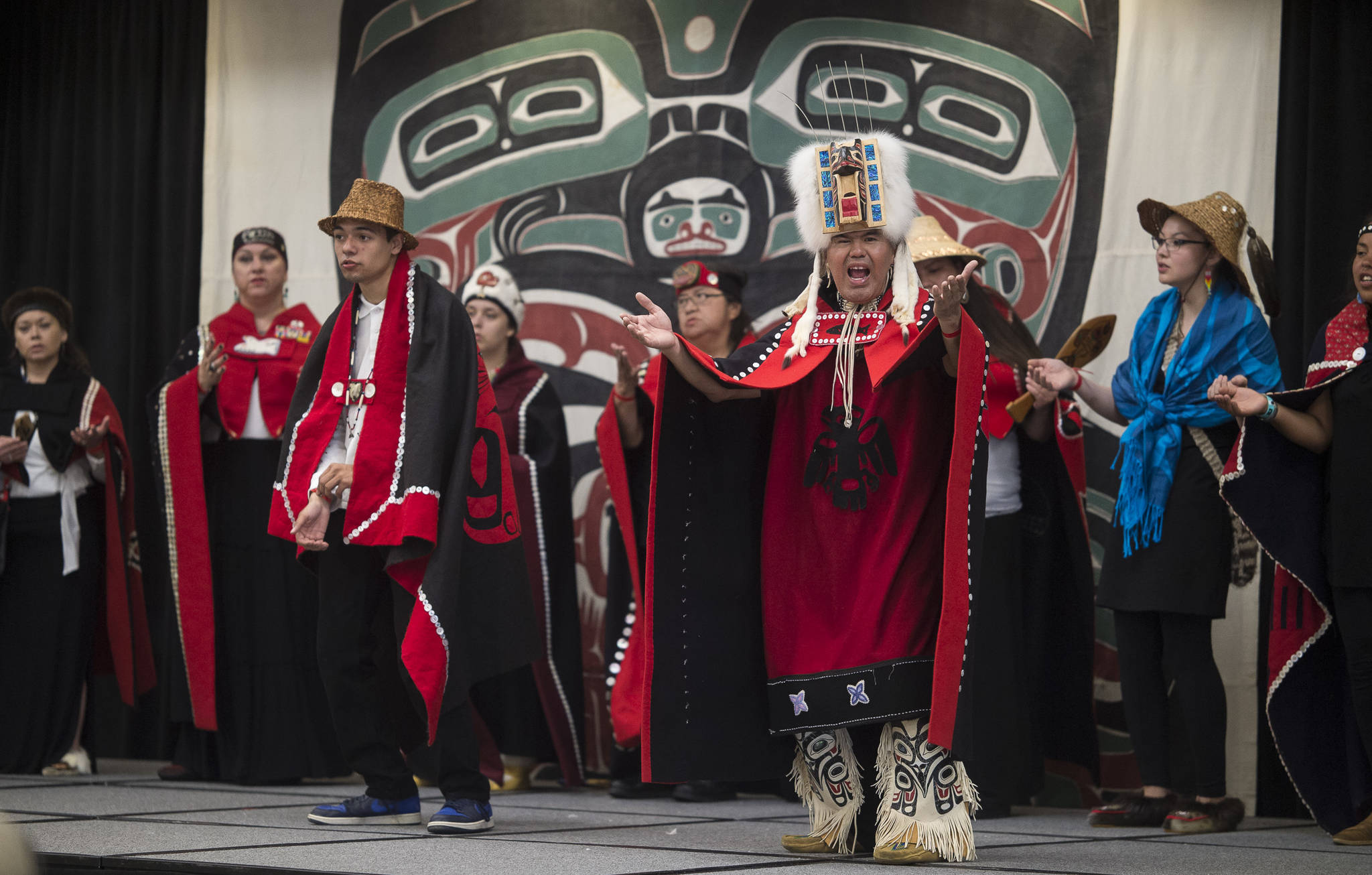Tiny Barril waited seven years for the song to come to him.
In 2010, Barril — a Tlingit dance leader who lives in the Seattle area — was telling his auntie that he wanted to write a song and knew what he wanted to say. He just didn’t know how to say it.
“Tiny, don’t think about it too hard,” she told him. “One day, you’re going to be by yourself and it’s going to come to you. You’re just going to go pick up the drum and the song is going to come to you.”
Just before Christmas in 2017, Barril was sitting in his living room when he picked up the drum near his family’s Christmas tree. It had finally come to him, like he said, like a Christmas present from his auntie. Continuing to give the gifts of song and dance to younger people, Barril said, is one reason he’s been coming to Celebration since 1990.
Barril sang that song Thursday as the members of his dance group Kutéeyaa danced off the stage in their finale. The song is called “T’akdeintaan Exit Song” for now, named after Barril’s Tlingit clan in the Raven moiety.
Dances began at 9 a.m. Thursday and continued for more than 12 hours at Centennial Hall and Elizabeth Peratrovich Hall. Groups from around the state and region took the stages for half an hour at a time. Most groups are from Southeast Alaska, but some came from out of state to participate.
Kutéeyaa was one of them. Kutéeyaa means “totem,” Barril explained, and they chose that for their group name because multiple clans are represented in the group. Multiple age groups are also present in the group, with one of the main dancers Thursday being a young man. Barril said being able to share the music with members of the younger generation is a major reason for continuing to perform at Celebration.
“It’s about our homes, it’s about our ancestors who have left us,” Barril said. “They’ve given us a treasure that we need to pass on to the younger people.”
Getting younger people involved was a theme when dance leaders spoke Thursday, both on stage and in interviews.
The Selkirk Spirit Dancers, from Pelly Crossing in Yukon, Canada, included a couple dozen children. The creation of the group, named for the Selkirk First Nation tribal government in Yukon, stemmed from a child’s question.
When she was 12 years old, Carmen Baker moved to Pelly Crossing with her family. Her family is Northern Tutchone (her sister April said they are part Tlingit as well), but Carmen saw when she arrived that none of the people were singing their traditional songs.
“What I noticed was the language and the songs and the teachings were sleeping,” Baker said, “so I asked them, ‘How come they don’t dance and they don’t drum?’ She told me, ‘The story is because of residential school.’”
Residential schools in Canada were instituted in the 1800s to try to get indigenous children to learn English and Christianity. The schools discouraged children to speak their languages, and many schools kept the children away from their parents.
Baker spoke to the crowd at Centennial Hall about this, saying she worked to create this dance group for years in order to help revive Northern Tutchone culture. The group started in 2006 with six little girls, Baker said. Now it has more than 30 members.
The dancers ranged from an infant to elders, with the women and girls wearing moose-hide dresses and the men and boys wearing moose-hide vests. They danced in a half-circle, with two or three people at a time stepping into the center and dancing. The baby, Lyric Baker, even “danced” at one point as his mother, Kaylyn Baker, stood him up and swung her son’s arms in time with the music.
Groups from far and wide come together this week has created a diverse array of styles and approaches. Lyle James, one of the leaders of Juneau-based dance group Woosh.ji.een, said it lifts his spirits to see groups from all over the region sharing what their ancestors have given them.
“I enjoy it a lot because what it does, it shows how all our cultures are not dying,” James said, “but they are very much in progress of thriving.”
Part of keeping culture alive, Barril said, is getting young people involved in the dances. He said it can be tough in the Seattle area to get children involved because there are so many distractions. As he looked over the crowd at Elizabeth Peratrovich Hall on Thursday, though, he saw young people joining in with the songs.
“You see the kids, they want to jump out there and dance, too,” Barril said. “We never discourage it. If they want to get up and dance, get up and dance.”
• Contact reporter Alex McCarthy at 523-2271 or amccarthy@juneauempire.com. Follow him on Twitter at @akmccarthy.

